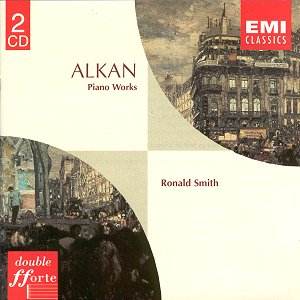Ronald Smith has made the presentation of Alkan's piano
music a large part of his life's work. Smith's adventures among the
Alkan legacy seem to have been part of my classical music background
dating well back to the late 1960s. It is a delight that he has recorded
so much of this composer's music and that EMI have now lovingly transferred
more than two and half hours of his tapes to CD.
There is no special mystery to Alkan. The way he is
sometimes portrayed one would think that one had to be initiated into
the mysteries before one could hope to appreciate his music. In fact
it is approachable by anyone who can take a style that inhabits a world
between Beethoven (Waldstein, Appassionata, Moonlight), Chopin (Waltzes
and the sonatas) and Liszt (Gnomenreigen and the Sonata). Smith's touch
and his feeling for colour is phenomenal.
The Op. 33 Sonata is in four movements each exploring
the essence of life's decades. The fact that it never reaches the sixties
is a comment on the expectation of longevity in the 1850s. Vingt
ans is haltingly imaginative touched with bel canto (3.12).
Trente ans - quasi Faust is instinct with explosive drama (1.13)
which contrasts with the pacific Quarante ans - Un heureux ménage.
The finale Cinquante ans - Prométhée enchâiné
comprises a hesitant questing and finally a dramatic gesture undermined
by a mournful philosophical resignation.
The Four Etudes from Op. 39 include a volplaning
Mendelssohnian race, an essay in stern nobility, an irate and bass heavy
imprecation and a playfully accented dance rather like Three Blind
Mice roughly chopped.
La Chanson de la Folle au bord de la mer is
remarkably imaginative and I owe it to Gordon Rumson for introducing
me to this extraordinary piece. The Allegro barbaro is a pretty
amazing approach to Shostakovich in its pugnacious jaw-set. It is worth
recalling that Smith recorded a memorable studio performance of the
Shostakovich Second Piano Concerto in 1979. This was a BBC event
with the Concert Orchestra conducted by Norman Del Mar. A striking antidote
to sentimentality.
The first and third movements of the Op. 61 Sonatine
are stylistically similar to Saint-Saëns with whirling Cossack
interludes and Chopin-like waltz episodes along the way. The very strange
second movement suggests powdered wigs and has a stately 'olde worlde'
English Warlockian feeling. The finale hints at the sort of brusque
whirl we associate with Bartók in his village dances. This is
crossed with and zither evocations as harmonic pepper. The Trois
Grandes Etudes have a grandeur redolent of the Granados's Goyescas
and then Handelian arpeggiation finishing with mephisto velocity.
The first Etude is for left-hand only; the second for the right-hand
and the third mouvement semblable et perpétuel, for both
hands. Finally come the Etudes de Bravoure with their Beethovenian
musculature and Russian prestissimo.
Rob Barnett
